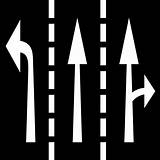This is UK-specific.
I've reversed the OP's definitions of outer & inner as they're opposite to convention.
Outside/offside is the side the driver sits. Inside/nearside is the passenger's side. In the UK from left to right we have inner, centre/middle, outer lanes. Because 'outside' on a straight road & 'outside' on a roundabout can be counter-intuitively opposing, it's best to refer to nearside, centre and offside; left, middle and right, or number the lanes, starting on the left.
If the lanes are simply concentric, then the idea is that you move over one lane to your left at the end of each junction, before the next. Some roundabouts break the laning periodically to allow you do do this without crossing a white line. Some don't.
This is still common for two-lane roundabouts, less so for three-lane.
This seems to have got more problematic over the past couple of decades, and generally lane discipline has got worse. A smaller percentage of people seem to know how to do it properly.
One way to avoid this confusion in the UK was with the introduction of spiral roundabouts. On a spiral roundabout, if you start in the offside [3rd] lane to turn right [3rd exit], then without crossing any lane lines at all, by the time you get to the 3rd exit, you will have spiralled out & now be in the nearside [1st] lane (or occasionally middle, 2nd lane depending on the exit laning strategy).
These roundabouts also also tend to expand from 2 to 3 lanes as you approach the roundabout itself, to try prevent 'discussions', yet the exits are just 2-lane. See https://www.drivingcrawley.co.uk/blog/how-to-deal-with-spiral-roundabouts which also shows how the lane arrows are displayed.
BTW, no-one, no matter spiral or concentric, should be trying to exit from the 3rd lane - crossing two lanes to exit is going to get you dented. Even the middle lane isn't truly safe for that; you have to have your wits about you. Not all roundabouts are equal & sometimes the locals have different habits for different exits… no matter what the markings say. This is not exactly legal & not exactly safe, but it is exactly what happens.
Here's an idealistic drawing of a spiral roundabout. Note that lane 2 at each exit is allowed to turn off or continue. Lane 1 must exit.
These are the ones you need to be most careful of.

This what you need to watch out for. You're in blue, going straight over. The lanes give you the right to do this. The idiot in red jumps the left lane to go straight over too. It's his fault when you hit him, but both cars get dented just the same.

Don't do this. Don't cross lanes as you exit. Stay in the outside [offside] lane until clear of the junction & you can properly determine if someone is on your inside [nearside]. They could have come from the left as you exited & you may not have seen them.

This is a typical 2-lane roundabout. Note that if you enter from the bottom of the picture in the left lane, you can go straight, or turn left. Note also that someone coming from your right in the 2nd lane on the roundabout, is quite within their rights to cut across you and exit to the left-most junction.
It's their right of way, not yours, because you must give way to the right.

Just to complete the set - some roundabouts also have traffic lights, which means the normal give way rules don't apply. You follow the lights instead.
Some, however, only have peak period lights [rush hour] - so if the lights are off, the normal give way rules do apply.
A word of warning: You always give way to traffic already on the roundabout. However, if it's busy someone might flash or wave to let you in. Just because they let you in doesn't mean the guy coming through on the next lane did too. Ease gently out & make sure it's clear or that lane has also stopped to let you in.
Source - https://www.accord-driving-school.com/spiral-roundabouts
Note: most sat navs these days [including on mobile phones] have lane-assist, so you will get some [small] notice of which lane to start in on larger roundabouts.
Also note: 3 lanes isn't the maximum, nor 4 exits. There are also roundabouts that are part roundabout, part straight through the middle [cut-through]. They're quite rare but you need to be prepared. There's also the infamous 'magic roundabout' which is a large roundabout, surrounded by lots of mini-roundabouts… which scarily means you can travel either way round them. I only know of two in the whole country, Swindon & Hemel Hempstead, so if you're not going there, don't worry.
This covers a good few of those types - https://www.passmefast.co.uk/roundabout-types
A clarification of the arrows you might see.
Because it's hard to indicate simply with an arrow that you have to go round to go right, the 'roundness' is ignored. Therefore an arrow pointing left is 'this junction'. One pointing straight is 'next junction' and one pointing right is 3rd [or higher] junction, keep going round.
This image is, 1. 'this junction', 2. 'next junction', 3. also 'next junction', or 'keep going round' [3rd junction or more].
The 'next junction' in this instance, you can exit from either the left or centre lanes. [The original left turn lane will have disappeared & a new right lane replaced it, so you've moved a lane to the left without crossing a line.]

Above all - if you keep your head, none of this is as bad as it looks.
I live near & regularly travel via four of the UK's most crash-prone roundabouts - all on London's A406, North Circular - & I haven't hit anything yet.





